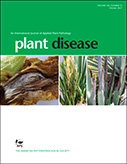Despite the negative impact of common scab (Streptomyces spp.) on the potato industry, little is known about the genetic architecture of resistance to this bacterial disease in the crop. We evaluated a mapping population (∼150 full sibs) derived from a cross between two tetraploid potatoes (‘Atlantic’ × B1829-5) in three environments (MN11, PA11, ME12) under natural common scab pressure. Three measures to common scab reaction, namely percentage of scabby tubers and disease area and lesion indices, were found to be highly correlated (>0.76). Because of the large environmental effect, heritability values were zero for all three traits in MN11, but moderate to high in PA11 and ME12 (∼0.44 to 0.79). We identified a single quantitative trait locus (QTL) for lesion index in PA11, ME12, and joint analyses on linkage group 3, explaining ∼22 to 30% of the total variation. The identification of QTL haplotypes and candidate genes contributing to disease resistance can support genomics-assisted breeding approaches in the crop.[Formula: see text] Copyright © 2021 The Author(s). This is an open access article distributed under the CC BY 4.0 International license .
Quantitative Trait Locus Mapping for Common Scab Resistance in a Tetraploid Potato Full-Sib Population
Citation: da Silva Pereira, G.; Mollinari, M.; Qu, X.; Thill, C.; Zeng, Z. B.; Haynes, K.; Yencho, G. C. 2021. Quantitative Trait Locus Mapping for Common Scab Resistance in a Tetraploid Potato Full-Sib Population. Plant Disease. ISSN 1943-7692. 105(10). pp. 3048–3054.
2022-04-01
BREEDING, CROP AND SYSTEMS SCIENCES CSS, GENETIC RESOURCES, GENETICS, GENOMICS AND CROP IMPROVEMENT SCIENCES GGCI, POTATO AGRI-FOOD SYSTEMS, POTATOES
journal_article

